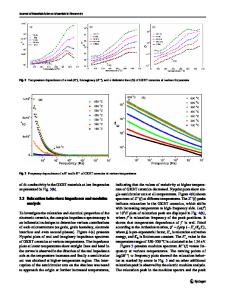Enhanced dielectric properties and dispersive phase transformation of Nb 5+ -doped BaZr 0.1 Ti 0.89 Fe 0.01 O 3 ceramics
- PDF / 1,410,419 Bytes
- 8 Pages / 595.276 x 790.866 pts Page_size
- 69 Downloads / 376 Views
Enhanced dielectric properties and dispersive phase transformation of Nb5+-doped BaZr0.1Ti0.89Fe0.01O3 ceramics Yun Liu1, Yuanliang Li1,* Yueshan Mi1 1
, Zhanshen Zheng1, Lifang Zhang1, Kaibiao Xi1, and
Key Laboratory of Environment Functional Materials of Tangshan City, Hebei Provincial Key Laboratory of Inorganic Nonmetallic Materials, College of Materials Science and Engineering, North China University of Science and Technology, Tangshan 063210, Hebei, China
Received: 3 July 2020
ABSTRACT
Accepted: 31 August 2020
In this article, the Nb5?-doped BaZr0.1Ti0.89Fe0.01O3 ceramics were prepared by sol–gel method. The effects of the crystallographic structure, micro-morphology, dielectric properties, and dispersive phase transition of Nb5? dopant BaZr0.1Ti0.89Fe0.01O3 ceramics were studied. The results show that all samples show a unitary characteristic perovskite-type peak. The dopant of Nb5? could increase these samples density and the grain size, thereby improving their electrical properties. The increase of dispersive phase transition can be ascribed to the larger grain size and the decrease of long-range ordered micro-regions. When the Nb5? doping amount is 0.75 mol%, it has the largest dispersive phase transition and the optimal dielectric properties: e25 °C = 7671, Tc = 40 °C, tand = 0.0067, and c = 1.89.
Ó
Springer Science+Business
Media, LLC, part of Springer Nature 2020
1 Introduction Energy, information, and materials are recognized as the three pillar industries in the twenty-first century. The development of materials provides a powerful guarantee for the efficient use of energy and information. Functional materials are an integral part of it. With the continuous development of industrialization, the concept of protecting the environment has been strengthened [1]. Some fields have put forward more stringent requirements to functional ceramics. For example, aerospace, environmental monitoring,
Address correspondence to E-mail: [email protected]
https://doi.org/10.1007/s10854-020-04394-4
mobile communication, etc., additionally, environment friendly, large capacity, and micro-capacitors are also widely demanded [2,3]. Barium titanate (BT) is the first lead-free ceramic used in capacitors, and it has a large dielectric constant with a small dielectric loss; therefore, BT-based ceramics are also known as ‘‘the pillars of the electronics industry in the future [4].’’ The dielectric coefficient of pure barium titanate sharply reduces around the Curie temperature, so its temperature stability is poor, which affects its application in industrial production. With the joint efforts of scholars at home and abroad, the dielectric
J Mater Sci: Mater Electron
temperature stability was optimized by the preparation processes, element doping, and material compounding [5–8]. In these methods, changes in element doping and preparation processes are very effective in improving the dielectric temperature stability and dispersive ferroelectric phase transition of BT ceramics. The doping modification often replac
Data Loading...











